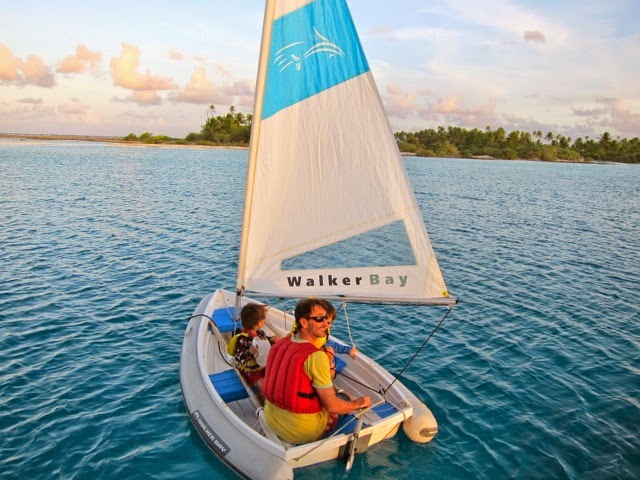
Spawned
I was awoken in the middle of the night by the unmistakable sound of water rushing past our hull.
We had anchored towards the head of Estero Pailad, a long fjord-shaped bay that opens up into wide shallows above us. The tides here are six meters – we took that into account when we had anchored at high tide in the afternoon. But we had no idea that the place turned into whitewater on the ebb.
It was much, much more current than I had ever heard around one of our boats. Clearly enough to be dangerous.
I was on deck in a second. The water boiled all around us…but the anchor chain was slack. I looked again at all the boils and ripples in the water – and at all the fish.
We were surrounded by masses of a small pelagic fish. It was actually slack water, and the turbulence on the surface of the water and the noise down below that had been loud enough to wake me up was just due to the million or so (no joke) fish in our near vicinity.
So that was why the Estero was alive with Chilean dolphins and South American sea lions. These animals were feeding all around us, leaving trails of bubbles all around the boat as they chased the fish. Whatever the fish were, we figured they must have been spawning to be aggregated in such numbers.
Alisa and I took in the spectacle for a few minutes, then went back to bed and marveled at the sounds the fish made inside our boat.
The next day, Elias pumped the head and managed to splatter shit up against the toilet seat.
(This is that romantic side of the life afloat that you might not have heard about.)
The head pump didn’t seem to be working, so I disassembled and serviced it. When the pump was back in place, it still didn’t work. I took it apart and replaced another valve. Same result.
Meanwhile, the sinks in the galley and our head were draining very slowly.
Do you see where this is going? There were so many fish the night before that some of them apparently lodged themselves in the seacocks draining the sinks and supplying water to the head. (I have no explanation for why restricted water to the head makes it spew backwards.)
I managed to blow the head supply seacock clear with air from the dinghy footpump. One fish ended up in the cockpit (the drains communicate with the sea chest feeding the head and engine raw water supply) and another was floating at the top of the sea chest. We very tentatively identified them as South American pilchards, Sardinops sagax.
No amount of drain disassembly and foot pump action would clear the galley sink, so I gave up and put on my wetsuit.
In the water, I pulled another 17 of the buggers out of various through-hulls. Four had stuffed themselves into the sink drain to plug it, and five managed to fit into the head outlet.
I’ve never heard of a boat having all of its through-hulls stuffed full of fish like that. And it’s potentially a bit of a nuisance. Until I pulled them out, we had no use of the engine, sinks, or head.
I can’t figure if there were so many that they just randomly ran into our through-hulls when they were being chased by predators, or if there was some other reason they ended up in there.
I just hope I got them all…
Ripped off
For years we’ve made it a habit to hang the dinghies on halyards at night. It’s part of what we call the “Galactic way” – our general approach to operating the ship. If the dinghies are hanging out of the water, they’re a lot less likely to go wandering in the night.
On this last haulout, I saw that the topsides paint was getting scratched up where we hang the dinghy. So ever since we left Valdivia, we’ve been leaving both dinghies in the water every night, tied to the stern, just like most every other traveling sailboat does.
You can see where this is going.
Last night someone cut the painter of the Little Dipper, our hard rowing dinghy. And it is as gone as a dinghy can be.
We’re going to miss that little boat. Elias has rowed around a bunch of anchorages in it all by himself, and we had some ripping sails with it at Amanu last season. We still have the sailing rig, if you’re interested.
So, over seven and a half years of sailing we’ve now had two outboards and a dinghy stolen. I wonder if this makes us slow learners?
When we left Alaska to sail to Australia with our toddler for crew, we thought it was a once-in-a-lifetime thing. But then we had our second child, and bought our second boat, and sailed across the Pacific a second time. We’ve been living aboard for seven years now. Sometimes we wonder how long we’ll keep at it, but all we know for sure is that the end doesn’t seem to be in sight just yet. Click here to read more from the Twice in a Lifetime blog.








